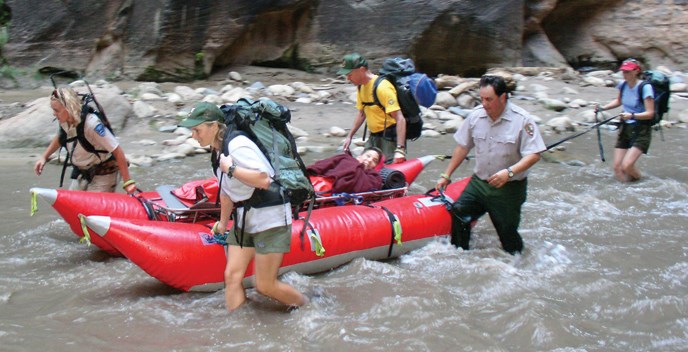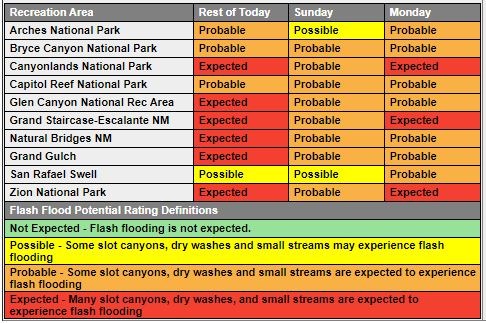
Plan Ahead and Be PreparedTraveling into the Virgin River Narrows, even on short trips, can be challenging and risky and requires careful planning before you begin. Your safety depends on your own good judgment, adequate preparation, and constant observation. Speak with park rangers at park visitor centers about current conditions, weather forecasts, and flash flood potential ratings. Flash Floods

Flash Flood Potential ForecastsNOT EXPECTED: Flash Flooding is not expected.
If you observe any of these signs, seek higher ground immediately. Even climbing a few feet may save your life. Remain on high ground until conditions improve. Water levels usually drop within 24 hours. Despite the forecast, flooding is possible at any time, and floods have occurred on days they were not expected. A possible or probable flash flood potential should be a serious cause for concern. Cyanobacteria and Water SourcesCarry enough water, one gallon per person per day, and drink it. Water is available at visitor centers, campgrounds, and the Zion Lodge. Water flow at natural springs can vary, check for information at visitor centers. Do not drink untreated water. Water collected in the wilderness is not safe to drink without treatment. Footwear and Trekking PolesHiking in the Virgin River is like walking on slippery bowling balls. It requires balancing on algae-coated rocks in the middle of a swiftly flowing river. Sturdy footwear is essential. Hiking boots with good ankle support are best. Sandals and bare feet are not appropriate. Inappropriate footwear often results in twisted ankles and crushed toes. Trekking poles are highly recommended and will help you maintain balace. Trekking poles can be also be used to check and measure water level depth when the river is cloudy with sediments. ClothingYear-Round: The temperature of the water in the Virgin River is often colder than the outside air temperature, breezes blow steadily, and very little sunlight penetrates to the canyon floor. Regardless of the time of year, always take additional warm clothing stored in a dry waterproof bag. Clothing made of wool or synthetic fibers has the best insulation. If you had to spend an unplanned night in the canyon due to an injury, how prepared would you and your group be? Water Depth and Dry BagsWater levels in the Virgin River Narrows, even when the CFS of the river is low, can range from ankle deep to full swims. Most of the time the river is ankle to knee deep, but all top-down hikers should be prepared for deep sections where swimming is required. Even the most experienced hikers occasionally fall in the Virgin River. It is a good idea to waterproof all of your belongings. Many hikers bring or rent dry bags to protect all of their gear. Smaller resealable bags provide extra protection for cameras and other valuables. Flashlight / HeadlampEvery week, hikers and canyoneers spend unintended nights camped in the Wilderness of the park. A headlamp could make the difference between spending the night in the canyon and making it out. First Aid KitEven a minor injury can cause major problems in the Zion Wilderness. Extra FoodFood keeps your energy up and helps you stay warm if you remain out overnight. Do Not JumpLower leg fractures are the most common injuries suffered in the Wilderness. The most common cause of lower leg injuries is jumping from rocks. Do not jump. HypothermiaHypothermia occurs when the body is cooled to dangerous levels. It is the number one killer of outdoor recreationists, even in summer, and it usually happens without the victim's awareness. It is a hazard in narrow canyons because immersion in water is the quickest route to body heat loss. To prevent hypothermia, avoid cotton clothing (it provides no insulation when wet) and eat high-energy food before you are chilled. The signs of hypothermia include: • Uncontrollable shivering Heat ExhaustionHeat exhaustion occurs when the body loses more fluid than is taken in. Signs of heat exhaustion include nausea, vomiting, fatigue, headaches, pale appearance, stomach cramps, and cool clammy skin. If a member of your party begins to experience any of these symptoms, stop your hike immediately. Find a cool, shady area and rest with your feet up to distribute fluids throughout your body. It is important to drink fluids, but it is also important to eat. Drinking lots of fluids and not eating, while suffering from heat exhaustion, can lead to a potentially dangerous condition of low blood salt. If heat exhaustion symptoms persist for more than two hours, seek medical help. Heat stroke is an advanced stage of heat exhaustion. It is the body's inability to cool itself. Symptoms include confusion, disorientation, behavior changes, and seizures. If you believe that a member of your party is suffering from heat stroke, it is imperative to cool them using any available means and obtain immediate medical assistance. |
An official website of the United States government
Here's how you know
Official websites use .gov
A
.gov website belongs to an official government
organization in the United States.
Secure .gov websites use HTTPS
A
lock (
) or https:// means you've safely connected to
the .gov website. Share sensitive information only on official,
secure websites.



